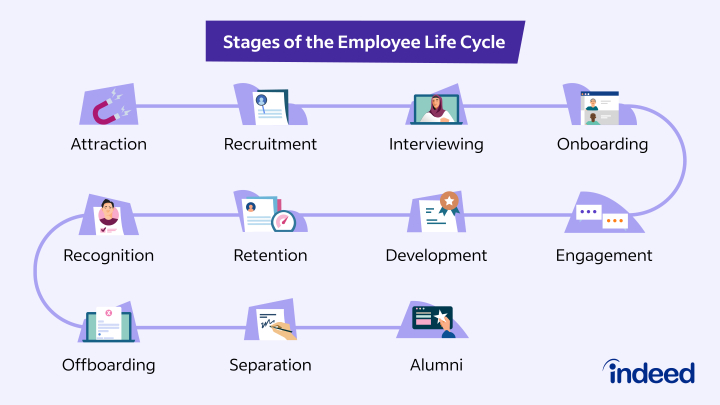What Is an Employee Life Cycle? Understand the 11 Stages
Updated May 26, 2023

Image description
A heading reads "Stages of the Employee Life Cycle" above a line that connects the various stages of the employee life cycle, each with these corresponding icons: - Attraction with a magnet
- Recruitment with a job application
- Interviewing with a laptop showing an interview
- Onboarding with employee profiles
- Engagement with text bubbles
- Development with an award
- Retention with a thermometer
- Recognition with an employee review
- Offboarding with an email
- Separation with a hand signing a document
- Alumni with a hand and a star
- Recruitment with a job application
- Interviewing with a laptop showing an interview
- Onboarding with employee profiles
- Engagement with text bubbles
- Development with an award
- Retention with a thermometer
- Recognition with an employee review
- Offboarding with an email
- Separation with a hand signing a document
- Alumni with a hand and a star
What is the employee life cycle model?
The employee life cycle model is an organizational model that individuals in human resources (HR) may use to visualize an employee's journey and understand how they advance through and engage with the organization. The model resembles the standard customer life cycle that companies often use because it's based on the idea that an employee's experience is just as valuable as a customer's experience. It's a comprehensive representation of the employees' experience that effectively provides a framework for engagement strategies. These strategies may ultimately benefit the organization by driving success, supporting engagement, reducing turnover and improving employee morale.Related: How To Create an Internal Hiring Process in 7 Steps
Stages of an employee life cycle
The exact stages of the employee life cycle may vary by organization. Some companies use a more comprehensive cycle with many stages, while others may combine stages to create a smaller cycle. The exact components of each stage may also vary for each organization and its unique culture. Here are the 11 stages of a more in-depth employee life cycle:1. Attraction
The employee life cycle typically begins the first time a potential hears about an organization. This stage doesn't involve an HR team interacting with the employee directly, but they may learn about the organization through a job post, general research or a similar natural discovery. The attraction stage may be easier for industry-leading organizations, prominent local businesses and well-known national brands than for smaller companies. However, it can still be an important and effective stage for companies of all sizes.2. Recruiting
The recruiting stage involves your first direct interaction with a prospective employee. The candidate learns more about the organization, its culture and the particular role they seek. Leveraging the organization's current employees and personal network may help you and other HR team members have a successful recruiting stage.Read more: FAQ: What Are the Stages of Recruitment (Plus Tips)3. Interviewing
The interviewing stage is one of the most important stages of the employee life cycle for both employees and employers. It allows both parties to learn more about each other and assess whether they're right for one another. While you may focus on qualifying whether the candidate has the required experience and could fit well within the organization, the candidate may evaluate if the company culture aligns with their needs and if the position may fulfill what they want in their career.Related: 13 Tips for Interviewing Candidates4. Onboarding
The onboarding stage includes welcoming new employees and helping them acclimate to their new position. This may involve collaboration between HR associates, the IT team and specific department managers. These efforts often include helping new employees complete paperwork, showing employees around the office and providing basic training or information sessions about the company and their new roles.Related: How To Successfully Onboard Employees in 7 Steps (With Tips)5. Engagement
The engagement stage may occur once a new employee has been in their role for a while. This stage focuses on promoting company culture and engaging employees with their work. This may help individuals feel more valued and find meaning in their work, ultimately helping them become more productive and encouraging them to stay with the company for a longer period.Read more: 10 Reasons Why Employee Engagement Is Important6. Development
The development stage focuses on helping an employee grow their career with the organization for which you work. This may include holding employee reviews, providing and requesting feedback and asking employees about their career goals. Promoting from within the organization and giving employees additional responsibilities may help them develop, and pay increases or additional benefits may also be beneficial during this stage.Related: Your Guide to Employee Development7. Retention
The retention stage explores ways to encourage employees to continue working for the company. While engaging and developing employees may help increase overall employee retention rates, it's often beneficial to focus on how to keep the highest-performing employees. These individuals may provide the most value to the organization and be challenging to replace. Listening to their feedback, implementing their suggestions and empowering and supporting their success may give them a reason to stay with the organization.Related: Understanding Customer Retention With Strategies8. Recognition
The recognition stage may help improve employee morale. Commending an employee on a job well done may help them feel valued and respected. It may also inspire others to succeed or encourage peers to recognize their coworkers' success.Read more: A Guide to Meaningful Employee Recognition9. Offboarding
The offboarding stage occurs when an employee leaves the organization, and the goal is often to achieve a smooth transition process. Suppose an employee provides you with their notice. It's often beneficial to use their remaining time with the organization to create a plan for what happens as they prepare to leave and after they leave the organization. For example, this may include designating responsibilities to others, providing cross-training and finishing projects. The offboarding stage also typically includes providing the employee with information about the end of their benefits and receiving their final paycheck.Related: How To Design an Effective Exit Interview Template10. Separation
The separation stage includes the actual act of leaving the company. It typically includes the employee returning their company assets, such as technology or access cards, and it may also have an exit interview to help understand their reason for leaving and learn ways the organization can improve. To create a positive memory and maintain a good relationship with the employee, you may also consider hosting a farewell lunch or informal gathering to celebrate their time with the organization.11. Alumni outreach
This stage involves maintaining a good relationship between the organization and the former employee. For example, the employee may be a resource for completing contract work or gaining future referrals to fill vacant positions. Similarly, employees may remain connected to the organization through their friendships with current employees.Showcase your skills with help from a resume expert
Advantages of implementing an employee life cycle model
Here are some of the benefits of implementing an employee life cycle model:Employee engagement
Employee engagement reflects employees' emotional connection with an organization and their contributions through their work. The employee life cycle model helps organizations identify ways to improve employee engagement by valuing, respecting and supporting the growth of each employee. Similarly, this model allows employees to visualize their potential long-term journey with the company. This may let them to see a future with the organization, strengthening their commitment to it.Related: 16 Employee Engagement Tools Companies Can UseTalent retention
The employee life cycle model helps organizations better understand how to allocate their resources. This may support more effective hiring measures, especially by identifying the most successful recruiting methods. Additionally, the model supports engaging and developing employees, encouraging them to work for the organization for longer periods. This may help reduce employee turnover rates and increase employee retention, reducing the costs and labor demands associated with recruiting and hiring.Related: The Real Turnover Cost of Losing an Employee (And Ways To Retain More Talent)Reputation improvement
By analyzing their employee life cycle model and the data about the employee journey that it provides, organizations may identify potential areas for improvement. Addressing these areas and employee concerns may improve the organization's operations and reputation. This may help you recruit and keep better talent, allowing you to create a more committed and driven workforce.Video: How To Motivate Employees with Dr. Athina Kanioura of PepsiCo
As Chief Strategy and Transformation Officer at Pepsico, Dr. Athina makes it her mission to keep her employees motivated so they can find true success in their roles.
Explore more articles
- 14 Examples of What To Say to a Micromanager
- What To Expect During an Internship Interview (With Tips)
- How To Write an Effective Persuasive Essay in 6 Steps
- How to Calculate Marginal Utility (With Example)
- How To Draw in Microsoft Word in 6 Steps (With Tips)
- Excused Absence vs. Unexcused Absence (Definition and Examples)
- 50 Quotes To Inspire Business Partnerships and Collaboration
- How To Write a Sick Out-of-Office Message (With Examples)
- What Is Preparation in Teaching and Why Is It Important?
- What Is Academic Writing? Definition and 7 Types to Consider
- How To Turn Your Idea into a Product in 10 Steps
- What Is a Problem Statement: Definition, How-To and Example


